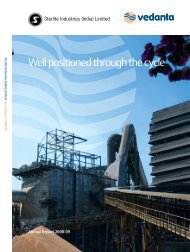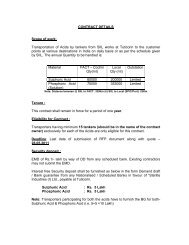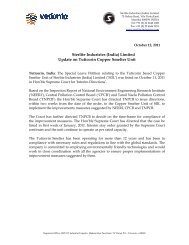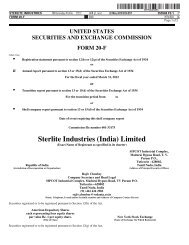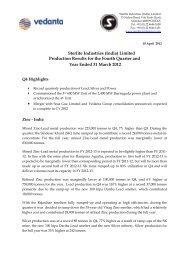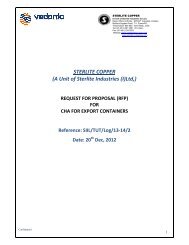Sterlite Industries (India) Limited - Sterlite Industries India Ltd.
Sterlite Industries (India) Limited - Sterlite Industries India Ltd.
Sterlite Industries (India) Limited - Sterlite Industries India Ltd.
Create successful ePaper yourself
Turn your PDF publications into a flip-book with our unique Google optimized e-Paper software.
Power Trading<br />
Power trading takes place between suppliers with surplus capacity and areas with deficits. Recent regulatory developments include the<br />
announcement of rules and provisions for open access and licensing related to interstate trading in electricity to promote competition. Several<br />
entities, including PTC <strong>India</strong> <strong>Limited</strong> (formerly Power Trading Corporation of <strong>India</strong> <strong>Limited</strong>), NTPC’s subsidiary, NTPC Vidyut Vyapar<br />
Nigam <strong>Limited</strong>, and Tata Power Trading Company Private <strong>Limited</strong> have started trading operations or have applied for trading licenses.<br />
Tariff Setting<br />
Until the end of 2005, the tariff regime in <strong>India</strong> for all electricity generators was regulated and determined by either the Central Electricity<br />
Regulatory Commission, or CERC, or the State Electricity Regulatory Commissions that set the tariff on a cost-plus basis consisting of a<br />
capacity charge, a variable energy charge and an unscheduled interchange charge. The tariff regime guaranteed a fixed return on equity to the<br />
generators and treated all costs as pass through in the tariff.<br />
In order to improve efficiency and provide cheaper electricity cost to consumers and at the same time attract adequate investments and<br />
accelerate development in the power sector, the Government of <strong>India</strong> notified the NTP in January 2006 with the key objectives of:<br />
• ensuring availability of electricity to consumers at reasonable and competitive rates;<br />
• promoting transparency, consistency and predictability in regulatory approvals across jurisdictions and minimising the perception of<br />
regulatory risks; and<br />
• promoting competition, efficiency in operations and improvement in quality of supply.<br />
To achieve these objectives, the NTP mandated that power procurement for future requirements by all distribution licensees should be<br />
through a transparent competitive bidding mechanism using the Guidelines for Determination of Tariff by Bidding Process for Procurement of<br />
Power by Distribution Licensees, dated January 19, 2005, issued by the Ministry of Power of the Government of <strong>India</strong>. Further, to facilitate a<br />
transparent competitive bidding mechanism, an availability-based tariff mechanism has also been introduced whereby the electricity tariffs are<br />
split into two parts comprising a fixed capacity charge and a variable energy charge. The fixed cost elements like interest on loans, return on<br />
equity, depreciation, operations and maintenance expenses, insurance, taxes and interest on working capital are covered by the capacity charge.<br />
The variable cost (that is, fuel cost) of the power plant for generating energy is covered by the energy charge.<br />
The NTP also provides that power purchase agreements should ensure adequate and bankable payment security arrangements like letters of<br />
credit and escrow of cash flows for the benefit of the generating companies. In case of persisting default, generating companies may sell power<br />
to other buyers.<br />
Government Initiatives<br />
Historically, management of the power sector by SEBs was driven by local populist politics that caused the financial health of central and<br />
state utilities to deteriorate, which led to under-investment, continued loss and theft and cash leakage. In response, the Government of <strong>India</strong><br />
launched a combination of regulatory and development initiatives which, among other measures, made anti-theft laws more stringent,<br />
prohibited unfunded subsidies and required 100% metering in all states.<br />
Initiatives have also been introduced to address poor transmissions and distributions infrastructure and dilapidated metering systems. These<br />
initiatives include concessional loans from the Government of <strong>India</strong> to fund up to half the costs of state transmissions and distributions projects<br />
and incentive payments to the states linked to the reduction in annual cash losses of the SEBs.<br />
The Accelerated Power Development and Reform Program, or APDRP, was implemented to accelerate reforms in the distribution sector by<br />
giving incentives and loans to state utilities to reduce Aggregate Technical and Commercial losses and outage interruptions. The APDRP has<br />
not been as successful as was initially planned. The Ministry of Finance has finalized a new APDRP, the Re-Structured Accelerated Power<br />
Development and Reform Program, or R-APDRP. The focus of the R-APDRP is on actual, demonstrable performance in terms of sustained<br />
loss reduction. Establishment of reliable and automated systems for sustained collection of accurate base line data, and the adoption of<br />
information technology in the areas of energy accounting, will be essential before taking up distribution strengthening projects. The R-APDRP<br />
is intended to cover urban areas, towns and cities with populations of over 30,000 people (10,000 in the case of special category states). In<br />
addition, in certain dense rural areas with significant loads, works of separation of agricultural feeders from domestic and industrial feeders and<br />
of high voltage distribution systems (11 kilovolt) will also be taken up.<br />
17



